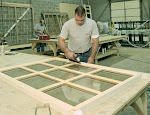 We have found that most specifications for the historic treatment of windows neglect to address the area of hardware restoration in sufficient detail. Most specifications dictate that existing hardware should be cleaned and repaired so it operates properly or replaced in kind if it is missing.
We have found that most specifications for the historic treatment of windows neglect to address the area of hardware restoration in sufficient detail. Most specifications dictate that existing hardware should be cleaned and repaired so it operates properly or replaced in kind if it is missing. Your typical historic wood double hung window has lifts, locks, pulleys, ropes or chains, and maybe pull sockets and sash stop adjusters. I am going to take a look at each of these elements to emphasize the importance of outlining the scope of work desired for a project in the construction documents.
Lifts
The typical historic restoration project has lift hardware in a wide variation of condition. On the same project you will find lifts that are tarnished, painted many times with the window interior, and missing completely. It is very important to define the desired finish of the restored lift. Most lifts are brass which can have a multitude of patinas or be polished to a US3 bright brass. Some are steel and will require plating to achieve a desired finish. There is a significant cost difference between just cleaning the existing lift and applying a custom plating. It also helps to have replacement lifts defined by model number rather than leaving it up to the contractor to guess what is a suitable facsimile. Architectural Resource Center is a good source for many of the styles of lifts and other historic window hardware and can be found at their website at http://www.aresource.com/ .
Locks
A high percentage of historic locks are either broken or missing on a typical restoration project so the replacement model is important if you want to assure a proper match to the existing. I would estimate that 8 0% of the locks on preservation projects are a standard sweep lock. The other 20% are specialty designs that may or may not be available to purchase over the counter. Often custom molds must be made for casting these one-of-a-kind elements. We see many historic projects that call for converting the sash to insulated glass or replacing the sash with a replica with insulated glass. These projects also call for restoring the locking hardware and applying it to the sash. Unfortunately, you cannot use the old lock on a sash with insulated glass because the thicker glass occupies the space where the old lock strike resided. You have to purchase a new replica lock with a narrow strike mount that is designed to fit the narrow channel.
0% of the locks on preservation projects are a standard sweep lock. The other 20% are specialty designs that may or may not be available to purchase over the counter. Often custom molds must be made for casting these one-of-a-kind elements. We see many historic projects that call for converting the sash to insulated glass or replacing the sash with a replica with insulated glass. These projects also call for restoring the locking hardware and applying it to the sash. Unfortunately, you cannot use the old lock on a sash with insulated glass because the thicker glass occupies the space where the old lock strike resided. You have to purchase a new replica lock with a narrow strike mount that is designed to fit the narrow channel.
 0% of the locks on preservation projects are a standard sweep lock. The other 20% are specialty designs that may or may not be available to purchase over the counter. Often custom molds must be made for casting these one-of-a-kind elements. We see many historic projects that call for converting the sash to insulated glass or replacing the sash with a replica with insulated glass. These projects also call for restoring the locking hardware and applying it to the sash. Unfortunately, you cannot use the old lock on a sash with insulated glass because the thicker glass occupies the space where the old lock strike resided. You have to purchase a new replica lock with a narrow strike mount that is designed to fit the narrow channel.
0% of the locks on preservation projects are a standard sweep lock. The other 20% are specialty designs that may or may not be available to purchase over the counter. Often custom molds must be made for casting these one-of-a-kind elements. We see many historic projects that call for converting the sash to insulated glass or replacing the sash with a replica with insulated glass. These projects also call for restoring the locking hardware and applying it to the sash. Unfortunately, you cannot use the old lock on a sash with insulated glass because the thicker glass occupies the space where the old lock strike resided. You have to purchase a new replica lock with a narrow strike mount that is designed to fit the narrow channel.Pulleys
 On most projects we see in the field, the pulleys have just been painted over and are completely neglected as part of the restoration process. We recommend removing the pulleys for restoration. All finishes should be removed and a new plating applied or a custom cover installed that has the desired finish. The wheel should also be lubricated to avoid squeaking during operation. Some projects call for replacing the ropes with chains because they are more durable and ascetically appealing. Remember that a rope pulley is distinct from a chain pulley so any change in material could involve a change in the pulley.
On most projects we see in the field, the pulleys have just been painted over and are completely neglected as part of the restoration process. We recommend removing the pulleys for restoration. All finishes should be removed and a new plating applied or a custom cover installed that has the desired finish. The wheel should also be lubricated to avoid squeaking during operation. Some projects call for replacing the ropes with chains because they are more durable and ascetically appealing. Remember that a rope pulley is distinct from a chain pulley so any change in material could involve a change in the pulley.Ropes and Chains
It is important to specify a rope that has a steel cable in the center for historic double hung windows. If you don't ask for this, you might have a conventional rope installed that isn't rated to handle the weight of the sash. Ropes without cables also have a tendency to stretch. There are many variations of sash chain with a host of finishes. We prefer solid brass, bronze, or stainless steel rather than plated steel since the plated steel has a proclivity to rust. It is important to use the size of chain that has the capacity to handle the weight of the sash and the size of the pulley. This can be challenging if you are converting the sash to insulated glass and thus increasing the weight of the sash.
Pull Sockets
The pull socket is usually a round brass socket fixed to the top rail of the upper sash. They are found on a third of the windows we work on. The socket allows the occupant to utilize a pole to secure to the socket allowing operation of the upper sash. On most projects, these sockets are just painted the same color as the sash. They should be finished in the same manner as the rest of the hardware so they match everything else and stand out as an architectural element.
Sash Stop Adjusters
The sash stop adjuster is that little grommet and fastener that hold the sash stop in place. I would estimate that half of the projects out there have this form of fastener. You will also find sash stop that is installed with finish nails. It is very important to install new sash stop adjusters in a matching finish to the other hardware. Most existing adjusters are either painted or tarnished and you really miss out on an opportunity to dress up the window by matching the other hardware finishes. Although the adjusters go for about $0.65 a piece, they are certainly worth it.
Fasteners
It is also important to specify the desired screws. If you don't call out for slotted or what are more commonly known as flat screws, you will get phillips screws since they are much easier to install with a screw gun. A truly authentic restoration will call for slotted screw heads to match the existing. We even run the slots in the same direction on all of the hardware for consistency.





